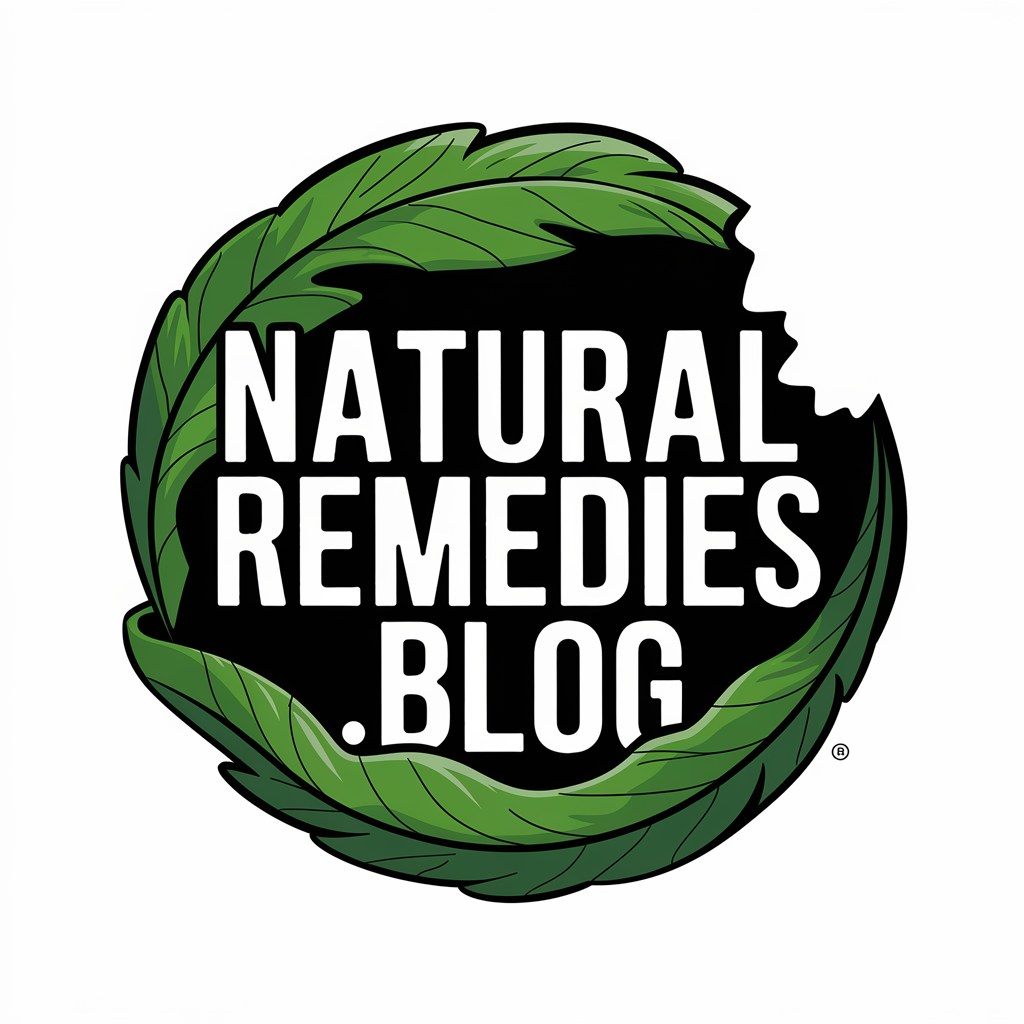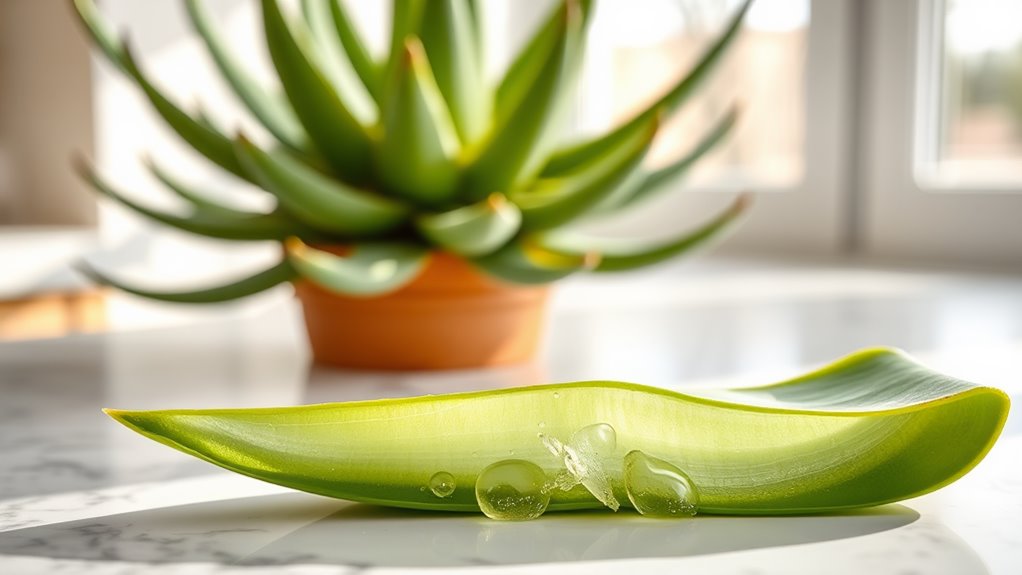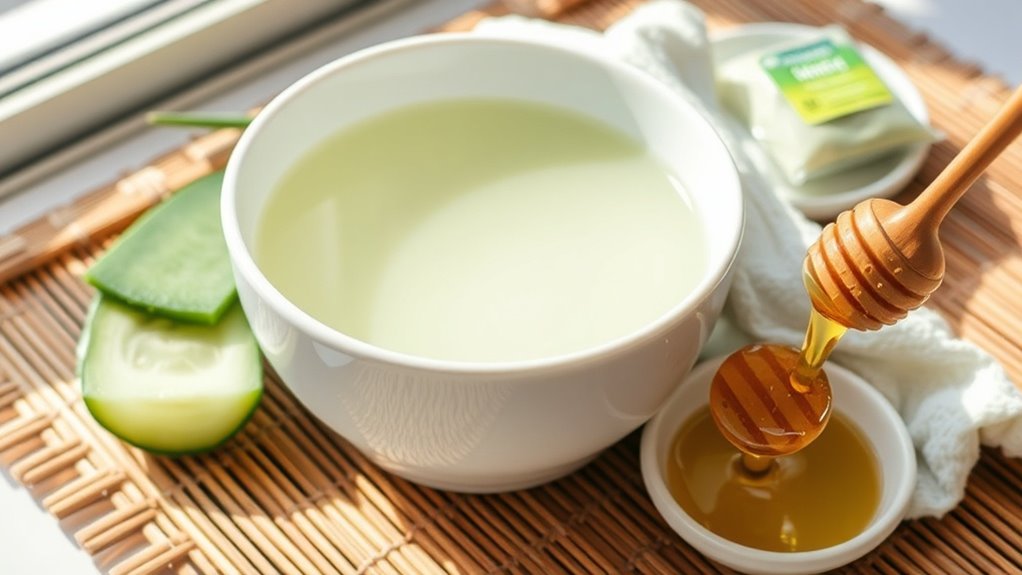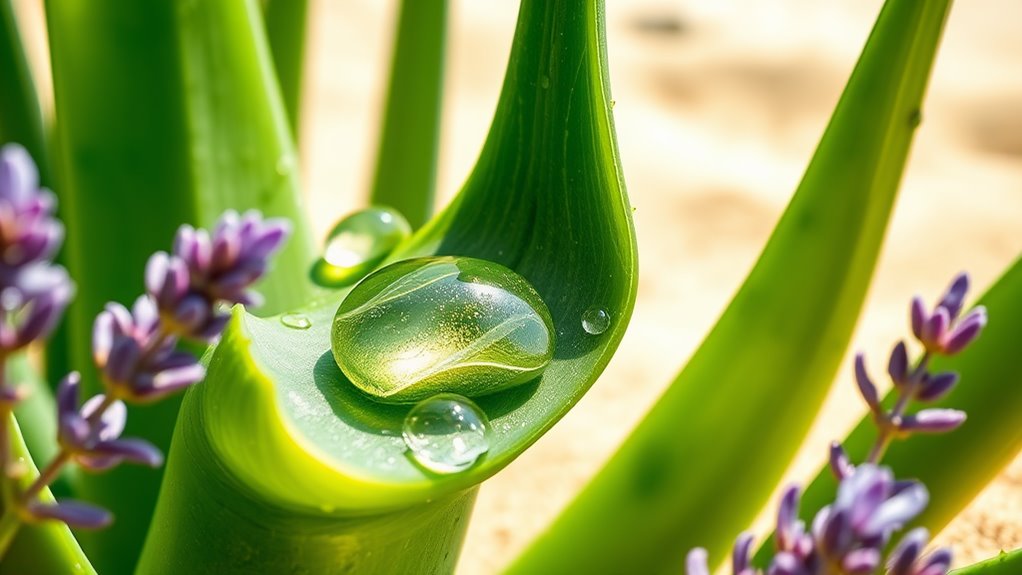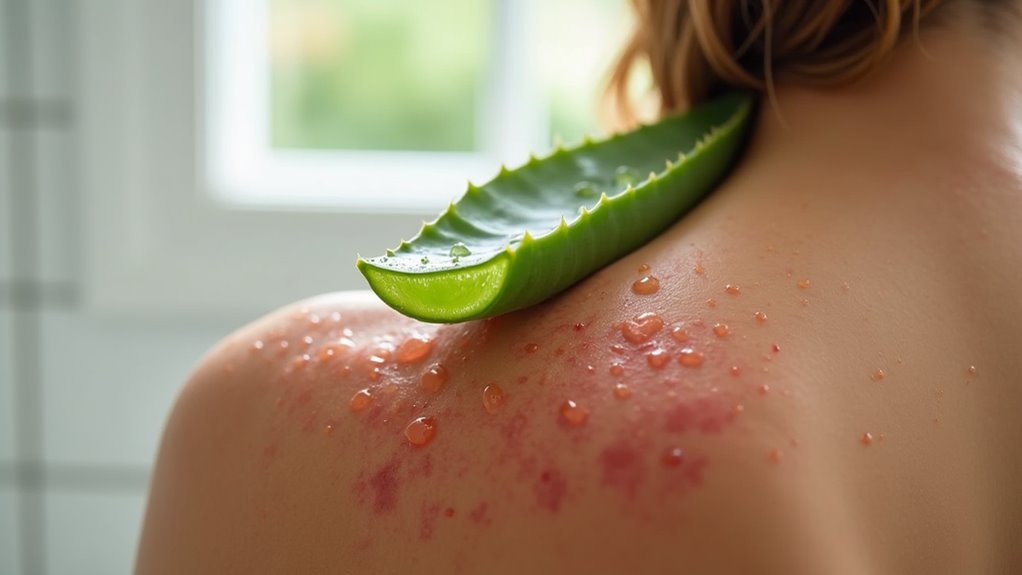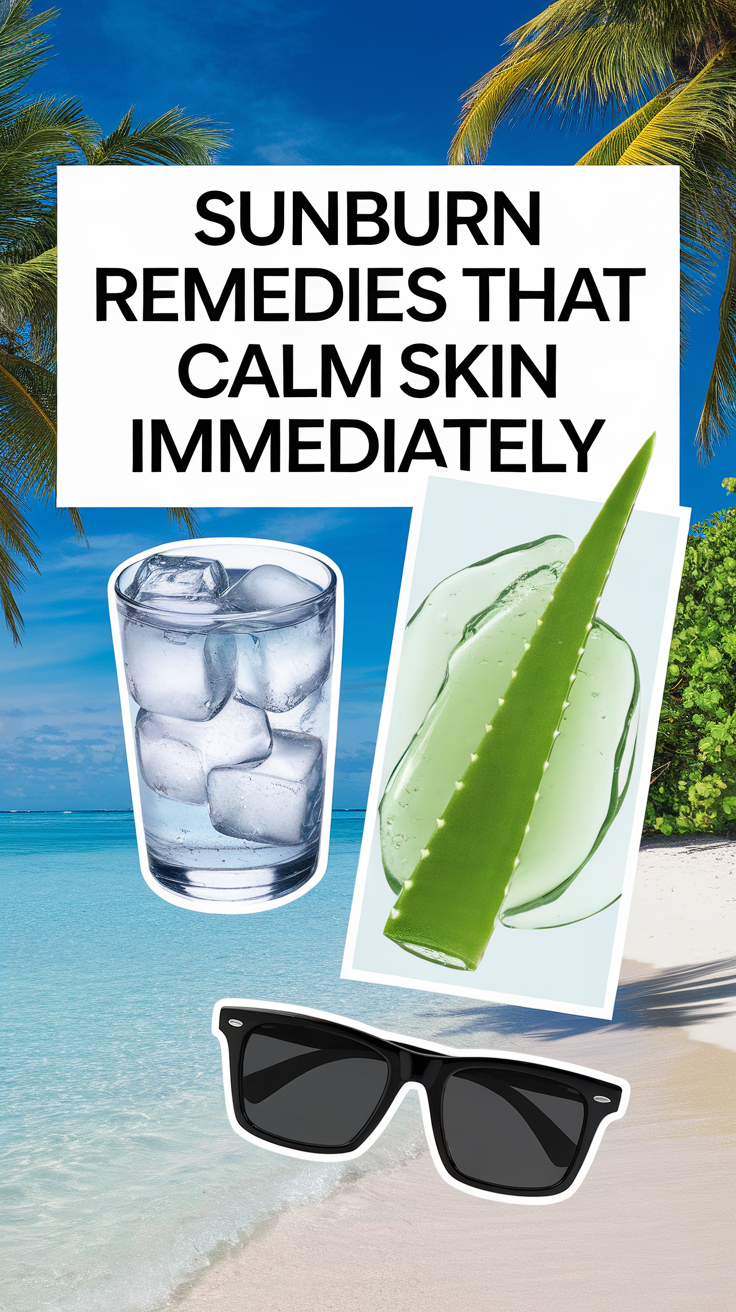Say Goodbye to Sunburn Fast With This Natural Trick
You can quickly relieve sunburn discomfort using aloe vera’s scientifically-proven healing compounds. This natural remedy works by activating anti-inflammatory responses through its polysaccharides and glycoproteins, while natural cooling compounds like acemannan reduce skin temperature and pain. Unlike chemical treatments that can irritate your skin, aloe vera penetrates deep to promote cellular repair and reduce inflammation. Understanding the specific mechanisms behind this ancient remedy reveals why it’s so effective for sunburn recovery.
Why Chemical Sunburn Treatments Might Not Be Your Best Option
While conventional sunburn treatments often provide temporary relief, many contain synthetic chemicals that may cause skin irritation or have unwanted side effects.
Common over-the-counter sunburn remedies frequently include parabens, artificial fragrances, and alcohol-based compounds that can further dry and damage your compromised skin barrier.
These chemical treatments might also mask underlying tissue damage without addressing the root cause of inflammation.
Research suggests that some synthetic ingredients can penetrate deeper skin layers, potentially causing cellular stress.
Instead of promoting natural healing, these products could interfere with your skin’s regenerative processes and delay recovery time. Additionally, natural remedies for sunburn like pure aloe vera gel and blended oatmeal powder can effectively soothe and heal damaged skin without the risk of irritation.
Understanding How Natural Remedies Work on Sunburned Skin
Natural remedies work on sunburned skin through multiple healing mechanisms that address both immediate discomfort and long-term recovery.
When you apply natural remedies like aloe vera, they penetrate your skin’s layers to reduce inflammation and provide cooling relief.
The plant compounds interact with your damaged cells, promoting repair while antioxidants neutralize free radicals caused by UV exposure.
Your body’s natural healing process accelerates as these remedies provide essential moisture, vitamins, and minerals.
They’ll strengthen your skin’s barrier function, decrease redness, and prevent peeling.
Unlike synthetic treatments, natural solutions work in harmony with your skin’s biological recovery mechanisms. Additionally, these remedies can help reduce inflammation and promote faster healing, making them a preferred choice for many.
The Science Behind This Ancient Healing Method
When you apply aloe vera to sunburned skin, its polysaccharides and glycoproteins trigger anti-inflammatory responses that reduce redness and swelling. The plant’s natural cooling compounds, including acemannan and anthraquinones, create an immediate soothing sensation while lowering the skin’s surface temperature. Your skin’s natural repair mechanisms are enhanced by aloe’s amino acids and antioxidants, which support cell regeneration and protect against further UV damage. Additionally, using aloe vera as a remedy aligns with the principles of natural sunburn relief, which target the biological mechanisms of skin inflammation for effective healing.
Aloe’s Anti-Inflammatory Properties
Scientists have long studied aloe vera’s remarkable anti-inflammatory compounds, particularly acemannan and aloin, which directly target the body’s inflammatory response. When you apply aloe to sunburned skin, these compounds suppress the release of prostaglandins, chemicals that trigger inflammation and pain.
Through this mechanism, aloe vera doesn’t just mask symptoms – it actively reduces redness, swelling, and discomfort at the cellular level.
Clinical studies show that aloe’s polysaccharides also stimulate your skin’s natural healing processes, increasing collagen production and promoting tissue repair.
This dual action of reducing inflammation while supporting healing makes aloe particularly effective for sunburn treatment.
Natural Cooling Compounds
The cooling sensation you experience when applying aloe vera stems from specific glycoproteins and polysaccharides that interact with your skin’s temperature receptors. These compounds trigger your TRPM8 receptors, which are the same neural pathways activated by menthol, creating an immediate cooling effect.
Your skin’s temperature actually decreases when these natural compounds penetrate the epidermis, reducing inflammation at the cellular level.
The plant’s enzymes, including bradykinase and catalase, work synergistically with the cooling compounds to accelerate healing and minimize tissue damage.
You’ll notice this cooling effect persists longer than with artificial alternatives due to aloe’s sustained molecular interaction with damaged skin cells.
Cell Repair Mechanisms
Ancient healing compounds found in aloe vera activate multiple cell repair pathways that accelerate your skin’s natural recovery process.
These compounds stimulate fibroblast proliferation, increasing collagen and elastin production to repair damaged tissue.
The plant’s glycoproteins and polysaccharides reduce inflammation while promoting cellular regeneration.
Your skin’s repair mechanisms respond to aloe’s bioactive molecules by increasing mitochondrial activity and ATP production.
This boost in cellular energy facilitates faster healing and reduces oxidative stress.
The plant’s antioxidant compounds neutralize free radicals while supporting your skin’s natural barrier restoration, effectively reversing UV-induced damage at the cellular level.
Step-by-Step Guide to Applying the Natural Solution
Following proper application steps guarantees maximum effectiveness when treating sunburn with natural remedies. You’ll need to gently cleanse the affected area with cool water and pat dry. Apply your chosen natural solution within 24 hours of sun exposure for best results. It’s important to remember that increased water intake is vital for skin recovery post-sunburn.
| Step | Action |
|---|---|
| 1 | Test patch on small area |
| 2 | Apply thin, even layer |
| 3 | Reapply every 2-4 hours |
Monitor your skin’s response and discontinue use if irritation occurs. Allow the solution to absorb completely before covering with loose, breathable clothing. Remember to stay hydrated and avoid additional sun exposure during the healing process.
Additional Tips to Speed Up Recovery
Stay hydrated by drinking 8-10 glasses of water daily to support skin repair. Avoid hot showers, as they’ll further dry your skin and intensify discomfort. Apply cool compresses for 10-15 minutes every hour to reduce inflammation. Wear loose, breathable cotton clothing to prevent friction against sensitive areas. Don’t peel or scratch damaged skin, as this increases infection risk. Get adequate rest and maintain a balanced diet rich in vitamins C and E to support cellular regeneration. Incorporating over-the-counter pain relievers can also help manage discomfort during the healing process.
When to Seek Medical Attention for Severe Burns
While most sunburns can be treated at home, certain symptoms require immediate medical attention.
You should seek emergency care if you experience severe blistering over more than 20% of your body, intense pain that doesn’t respond to over-the-counter medications, or signs of heat exhaustion.
Watch for symptoms like fever above 101°F, severe dehydration, rapid pulse, or confusion.
If you notice signs of infection, including yellow drainage, swelling, or red streaks extending from the burn, visit your doctor immediately.
Those with weakened immune systems should be particularly vigilant and seek medical evaluation for any severe sunburn. Additionally, symptoms of infection such as fever or drainage may indicate a need for professional care.
